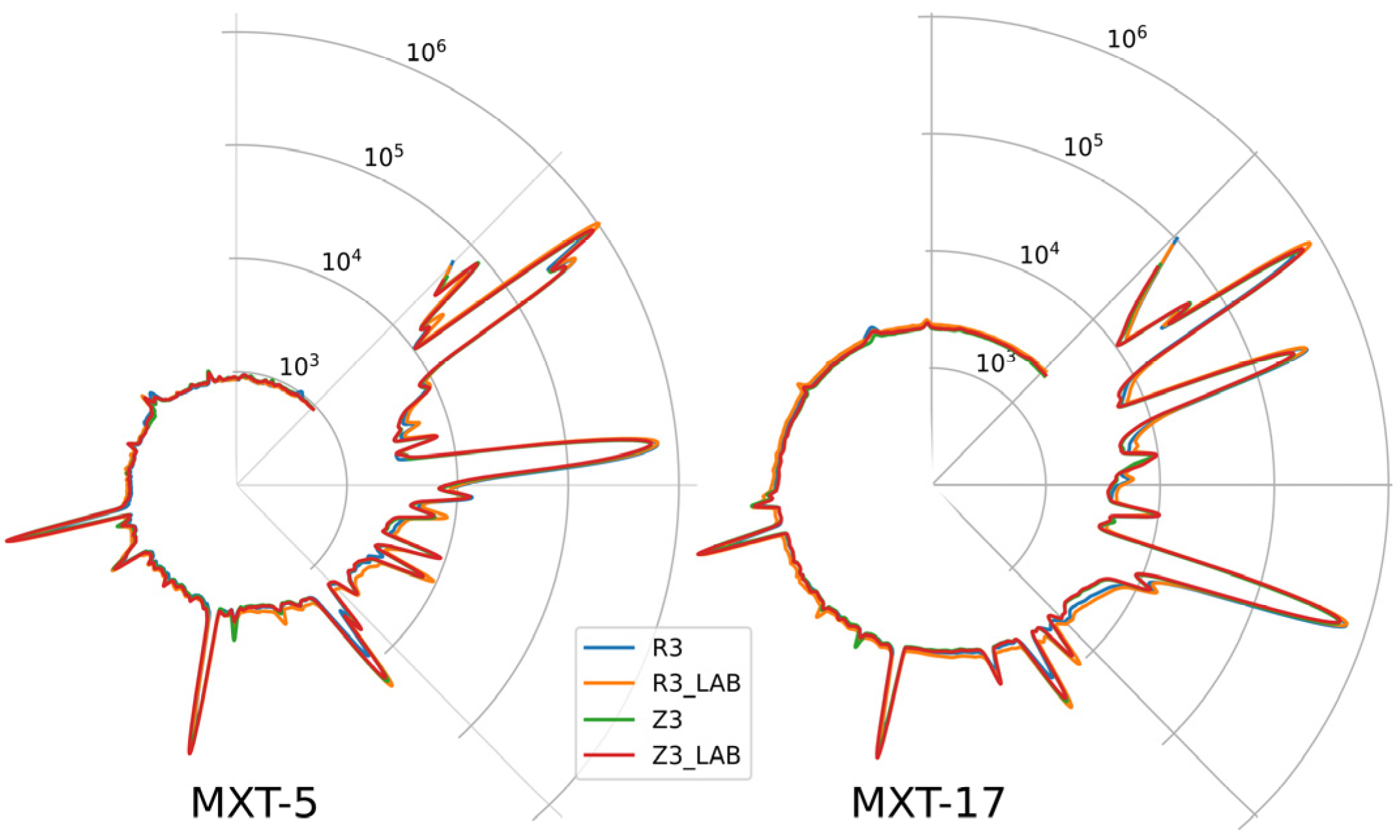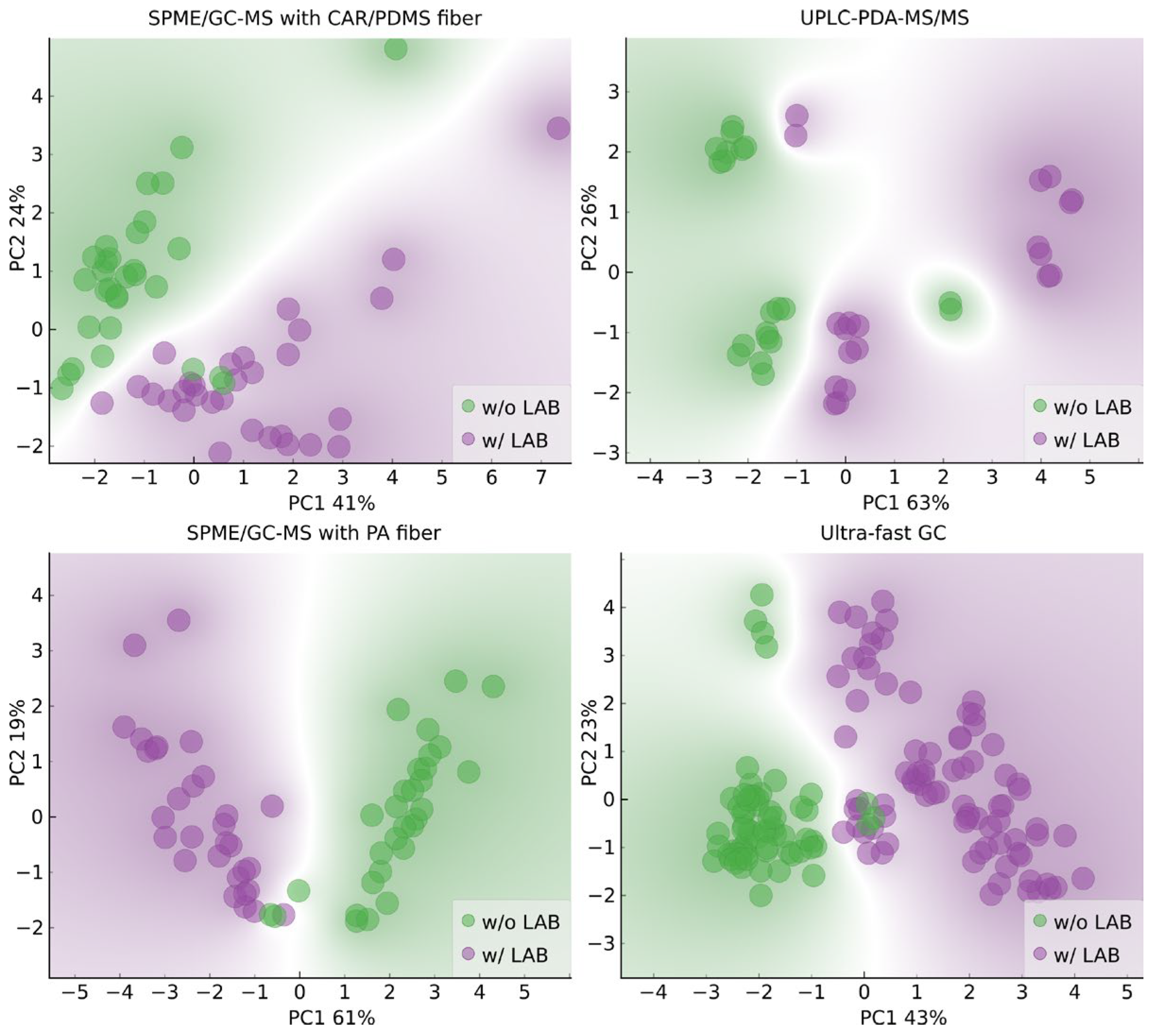The Use of Ultra-Fast Gas Chromatography for Fingerprinting-Based Classification of Zweigelt and Rondo Wines with Regard to Grape Variety and Type of Malolactic Fermentation Combined with Greenness and Practicality Assessment
Abstract
1. Introduction
2. Results and Discussion
3. Materials and Methods
3.1. Winemaking Process and Wine Samples
3.2. Ultra-Fast GC
3.3. Statistical Analysis
3.4. Greenness and Blueness Measurements of Chromatographic Methods
4. Conclusions
Supplementary Materials
Author Contributions
Funding
Institutional Review Board Statement
Informed Consent Statement
Data Availability Statement
Conflicts of Interest
References
- Cañas, P.M.I.; Pérez-Martín, F.; Romero, E.G.; Prieto, S.S.; Herreros, M.D.L.L.P. Influence of inoculation time of an autochthonous selected malolactic bacterium on volatile and sensory profile of Tempranillo and Merlot wines. Int. J. Food Microbiol. 2012, 156, 245–254. [Google Scholar] [CrossRef] [PubMed]
- Celik, Z.D.; Cabaroglu, T.; Krieger-Weber, S. Impact of malolactic fermentation on the volatile composition of Turkish Kalecik karası red wines. J. Inst. Brew. 2019, 125, 92–99. [Google Scholar] [CrossRef]
- López, R.; López-Alfaro, I.; Gutiérrez, A.R.; Tenorio, C.; Garijo, P.; González-Arenzana, L.; Santamaría, P. Malolactic fermentation of Tempranillo wine: Contribution of the lactic acid bacteria inoculation to sensory quality and chemical composition. Int. J. Food Sci. Technol. 2011, 46, 2373–2381. [Google Scholar] [CrossRef]
- Issa-Issa, H.; Hernández, F.; López-Lluch, D.; Uysal, R.S.; Carbonell-Barrachina, Á.A. Fondillón Wine Adulteration by Addition of Other Monastrell Wines. Beverages 2023, 9, 28. [Google Scholar] [CrossRef]
- Pesme, J.O. Tracing and tracking wine bottles: Protecting consumers and producers. Bio Web Conf. 2023, 68, 03028. [Google Scholar] [CrossRef]
- Geana, E.I.; Ciucure, C.T.; Apetrei, C.; Artem, V. Application of Spectroscopic UV-Vis and FT-IR Screening Techniques Coupled with Multivariate Statistical Analysis for Red Wine Authentication: Varietal and Vintage Year Discrimination. Molecules 2019, 24, 4166. [Google Scholar] [CrossRef]
- Popîrdă, A.; Luchian, C.E.; Cotea, V.V.; Colibaba, L.C.; Scutarașu, E.C.; Toader, A.M. A review of representative methods used in wine authentication. Agriculture 2021, 11, 225. [Google Scholar] [CrossRef]
- Alañón, M.E.; Pérez-Coello, M.S.; Marina, M.L. Wine science in the metabolomics era. TrAC—Trend. Anal. Chem. 2015, 74, 1–20. [Google Scholar] [CrossRef]
- Sun, X.; Zhang, F.; Gutiérrez-Gamboa, G.; Ge, Q.; Xu, P.; Zhang, Q.; Fang, Y.; Ma, T. Real wine or not? Protecting wine with traceability and authenticity for consumers: Chemical and technical basis, technique applications, challenge, and perspectives. Crit. Rev. Food Sci. 2022, 62, 6783–6808. [Google Scholar] [CrossRef]
- Duarte-Mermoud, M.A.; Beltrán, N.H.; Bustos, M.A. Chilean wine varietal classification using quadratic Fisher transformation. Pattern Anal. Appl. 2010, 13, 181–188. [Google Scholar] [CrossRef]
- Jaitz, L.; Siegl, K.; Eder, R.; Rak, G.; Abranko, L.; Koellensperger, G.; Hann, S. LC–MS/MS analysis of phenols for classification of red wine according to geographic origin, grape variety and vintage. Food Chem. 2010, 122, 366–372. [Google Scholar] [CrossRef]
- Karimali, D.; Kosma, I.; Badeka, A. Varietal classification of red wine samples from four native Greek grape varieties based on volatile compound analysis, color parameters and phenolic composition. Eur. Food Res. Technol. 2020, 246, 41–53. [Google Scholar] [CrossRef]
- Stój, A.; Czernecki, T.; Domagała, D. Authentication of Polish Red Wines Produced from Zweigelt and Rondo Grape Varieties Based on Volatile Compounds Analysis in Combination with Machine Learning Algorithms: Hotrienol as a Marker of the Zweigelt Variety. Molecules 2023, 28, 1961. [Google Scholar] [CrossRef] [PubMed]
- Stój, A.; Kapusta, I.; Domagała, D. Classification of red wines produced from Zweigelt and Rondo grape varieties based on the analysis of phenolic compounds by UPLC-PDA-MS/MS. Molecules 2020, 25, 1342. [Google Scholar] [CrossRef]
- Welke, J.E.; Manfroi, V.; Zanus, M.; Lazzarotto, M.; Zini, C.A. Differentiation of wines according to grape variety using multivariate analysis of comprehensive two-dimensional gas chromatography with time-of-flight mass spectrometric detection data. Food Chem. 2013, 141, 3897–3905. [Google Scholar] [CrossRef]
- Gliszczyńska-Świgło, A.; Chmielewski, J. Electronic nose as a tool for monitoring the authenticity of food. A review. Food Anal. Method. 2017, 10, 1800–1816. [Google Scholar] [CrossRef]
- Majchrzak, T.; Wojnowski, W.; Płotka-Wasylka, J. Classification of Polish wines by application of ultra-fast gas chromatography. Eur. Food Res. Technol. 2018, 244, 1463–1471. [Google Scholar] [CrossRef]
- Alahmad, W.; Kaya, S.I.; Cetinkaya, A.; Varanusupakul, P.; Ozkan, S.A. Green chemistry methods for food analysis: Overview of sample preparation and determination. Adv. Sample Prep. 2023, 5, 100053. [Google Scholar] [CrossRef]
- Gałuszka, A.; Migaszewski, Z.; Namieśnik, J. The 12 principles of green analytical chemistry and the SIGNIFICANCE mnemonic of green analytical practices. TrAC—Trend. Anal. Chem. 2013, 50, 78–84. [Google Scholar] [CrossRef]
- Manousi, N.; Wojnowski, W.; Płotka-Wasylka, J.; Samanidou, V. Blue applicability grade index (BAGI) and software: A new tool for the evaluation of method practicality. Green Chem. 2023, 25, 7598–7604. [Google Scholar] [CrossRef]
- Muhl, J.R.; Derycke, M.; Pilkington, L.I.; Fedrizzi, B.; Deed, R.C. A green liquid chromatography-tandem mass spectrometry method for the simultaneous analysis of volatile thiols and their precursors in oenological samples. J. Chromatogr. A 2023, 1707, 464273. [Google Scholar] [CrossRef] [PubMed]
- Nowak, P.M.; Kościelniak, P. What color is your method? Adaptation of the RGB additive color model to analytical method evaluation. Anal. Chem. 2019, 91, 10343–10352. [Google Scholar] [CrossRef] [PubMed]
- Pena-Pereira, F.; Wojnowski, W.; Tobiszewski, M. AGREE—Analytical GREEnness metric approach and software. Anal. Chem. 2020, 92, 10076–10082. [Google Scholar] [CrossRef] [PubMed]
- Nowak, P.M.; Wietecha-Posłuszny, R.; Pawliszyn, J. White Analytical Chemistry: An approach to reconcile the principles of Green Analytical Chemistry and functionality. TrAC—Trend. Anal. Chem. 2021, 138, 116223. [Google Scholar] [CrossRef]
- Stój, A.; Czernecki, T.; Sosnowska, B.; Niemczynowicz, A.; Matwijczuk, A. Impact of Grape Variety, Yeast and Malolactic Fermentation on Volatile Compounds and Fourier Transform Infrared Spectra in Red Wines. Pol. J. Food Nutr. Sci. 2022, 72, 39–55. [Google Scholar] [CrossRef]
- Abrahamse, C.E.; Bartowsky, E.J. Timing of malolactic fermentation inoculation in Shiraz grape must and wine: Influence on chemical composition. World J. Microbiol. Biotechnol. 2012, 28, 255–265. [Google Scholar] [CrossRef]
- Costello, P.J.; Francis, I.L.; Bartowsky, E.J. Variations in the effect of malolactic fermentation on the chemical and sensory properties of Cabernet Sauvignon wine: Interactive influences of Oenococcus oeni strain and wine matrix composition. Aust. J. Grape Wine R. 2012, 18, 287–301. [Google Scholar] [CrossRef]
- Izquierdo-Cañas, P.M.; García-Romero, E.; Mena-Morales, A.; Gómez-Alonso, S. Effects of malolactic fermentation on colour stability and phenolic composition of Petit Verdot red wines. Wine Stud. 2023, 2, 5795. [Google Scholar] [CrossRef]
- Suriano, S.; Savino, M.; Basile, T.; Tarricone, L.; Di Gennaro, D. Management of malolactic fermentation and influence on chemical composition of Aglianico red wines. Ital. J. Food Sci. 2015, 27, 310–319. [Google Scholar] [CrossRef]
- Stój, A.; Płotka-Wasylka, J.; Simeonov, V.; Kapłan, M. The content of biogenic amines in Rondo and Zweigelt wines and correlations between selected wine parameters. Food Chem. 2022, 371, 131172. [Google Scholar] [CrossRef]
- Robnik-Šikonja, M.; Kononenko, I. An adaptation of Relief for attribute estimation in regression. In Proceedings of the Fourteenth International Conference of Machine Learning, Nashville, TN, USA, 8–12 July 1997; Fisher, D.H., Ed.; Morgan Kaufmann Publishers Inc.: San Francisco, CA, USA, 1997; pp. 296–304. [Google Scholar]
- Todorov, A. An overview of the RELIEF algorithm and advancements. In Statistica Approaches to Gene X Environment Interactions for Complex Phenotypes; Windle, M., Ed.; MIT Press: Cambridge, MA, USA, 2016; Volume 10. [Google Scholar]
- Cristianini, N.; Scholkopf, B. Support vector machines and kernel methods: The new generation of learning machines. Ai Mag. 2002, 23, 31–42. [Google Scholar] [CrossRef]
- Luts, J.; Ojeda, F.; Van de Plas, R.; De Moor, B.; Van Huffel, S.; Suykens, J.A. A tutorial on support vector machine-based methods for classification problems in chemometrics. Anal. Chim. Acta 2010, 665, 129–145. [Google Scholar] [CrossRef] [PubMed]
- Pal, M. Random forest classifier for remote sensing classification. Int. J. Remote Sens. 2005, 26, 217–222. [Google Scholar] [CrossRef]
- Demšar, J.; Curk, T.; Erjavec, A.; Gorup, Č.; Hočevar, T.; Milutinovič, M.; Mozina, M.; Polajnar, M.; Toplak, M.; Starič, A.; et al. Orange: Data mining toolbox in Python. J. Mach. Learn. Res. 2013, 14, 2349–2353. [Google Scholar]
- Pedregosa, F.; Varoquaux, G.; Gramfort, A.; Michel, V.; Thirion, B.; Grisel, O.; Blondel, M.; Prettenhofer, P.; Weiss, R.; Dubourg, V.; et al. Scikit-learn: Machine learning in Python. J. Mach. Learn. Res. 2011, 12, 2825–2830. [Google Scholar]







| Method | Model | AUC | CA | Precision |
|---|---|---|---|---|
| SPME/GC-MS with CAR/PDMS fiber | SVM | 1.000 | 1.000 | 1.000 |
| RF | 0.999 | 0.981 | 0.981 | |
| UPLC-PDA-MS/MS | SVM | 1.000 | 0.993 | 0.993 |
| RF | 1.000 | 0.993 | 0.993 | |
| Tree | 0.943 | 0.943 | 0.949 | |
| SPME/GC-MS with PA fiber | SVM | 1.000 | 1.000 | 1.000 |
| RF | 1.000 | 0.990 | 0.991 | |
| Ultra-fast GC | SVM | 1.000 | 1.000 | 1.000 |
| RF | 1.000 | 0.998 | 0.998 |
| Method | Model | AUC | CA | Precision |
|---|---|---|---|---|
| SPME/GC-MS with CAR/PDMS fiber | SVM | 0.976 | 0.910 | 0.910 |
| RF | 0.954 | 0.933 | 0.934 | |
| UPLC-PDA-MS/MS | SVM | 0.995 | 0.971 | 0.971 |
| RF | 0.976 | 0.929 | 0.929 | |
| Tree | 0.843 | 0.807 | 0.808 | |
| SPME/GC-MS with PA fiber | SVM | 0.999 | 0.986 | 0.986 |
| RF | 0.983 | 0.957 | 0.959 | |
| Ultra-fast GC | SVM | 1.000 | 0.996 | 0.996 |
| RF | 0.999 | 0.984 | 0.984 |
Disclaimer/Publisher’s Note: The statements, opinions and data contained in all publications are solely those of the individual author(s) and contributor(s) and not of MDPI and/or the editor(s). MDPI and/or the editor(s) disclaim responsibility for any injury to people or property resulting from any ideas, methods, instructions or products referred to in the content. |
© 2024 by the authors. Licensee MDPI, Basel, Switzerland. This article is an open access article distributed under the terms and conditions of the Creative Commons Attribution (CC BY) license (https://creativecommons.org/licenses/by/4.0/).
Share and Cite
Stój, A.; Wojnowski, W.; Płotka-Wasylka, J.; Czernecki, T.; Kapusta, I.T. The Use of Ultra-Fast Gas Chromatography for Fingerprinting-Based Classification of Zweigelt and Rondo Wines with Regard to Grape Variety and Type of Malolactic Fermentation Combined with Greenness and Practicality Assessment. Molecules 2024, 29, 4667. https://doi.org/10.3390/molecules29194667
Stój A, Wojnowski W, Płotka-Wasylka J, Czernecki T, Kapusta IT. The Use of Ultra-Fast Gas Chromatography for Fingerprinting-Based Classification of Zweigelt and Rondo Wines with Regard to Grape Variety and Type of Malolactic Fermentation Combined with Greenness and Practicality Assessment. Molecules. 2024; 29(19):4667. https://doi.org/10.3390/molecules29194667
Chicago/Turabian StyleStój, Anna, Wojciech Wojnowski, Justyna Płotka-Wasylka, Tomasz Czernecki, and Ireneusz Tomasz Kapusta. 2024. "The Use of Ultra-Fast Gas Chromatography for Fingerprinting-Based Classification of Zweigelt and Rondo Wines with Regard to Grape Variety and Type of Malolactic Fermentation Combined with Greenness and Practicality Assessment" Molecules 29, no. 19: 4667. https://doi.org/10.3390/molecules29194667
APA StyleStój, A., Wojnowski, W., Płotka-Wasylka, J., Czernecki, T., & Kapusta, I. T. (2024). The Use of Ultra-Fast Gas Chromatography for Fingerprinting-Based Classification of Zweigelt and Rondo Wines with Regard to Grape Variety and Type of Malolactic Fermentation Combined with Greenness and Practicality Assessment. Molecules, 29(19), 4667. https://doi.org/10.3390/molecules29194667









